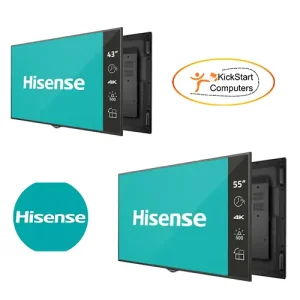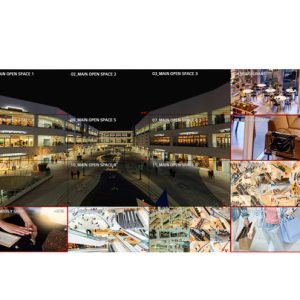Jump Ahead Too
ToggleVideo Walls | Applications, Components and Design
Introduction
In today’s digital landscape, video walls have become essential tools for captivating audiences and delivering immersive experiences. With advancements in technology, these dynamic displays play a crucial role in enhancing visual communication across various industries. This article delves into the technology behind video walls, their diverse applications, and the leading manufacturers driving this innovation.
Understanding Video Walls
Video walls consist of multiple display panels seamlessly configured to form a large visual canvas. They have evolved significantly from their origins in the 1980s, transitioning from basic multi-monitor setups to highly sophisticated displays capable of showcasing vibrant, high-resolution content. This section explores the evolution and transformative impact of video walls as effective communication tools.
Understanding Video Wall Costs
When considering the investment in a video wall, several key factors influence the overall cost. Brightness is a primary determinant—starting from standard displays at 350 cd/m², escalating to more luminous options at 500 cd/m², 700 cd/m², and beyond. High-end outdoor displays from top brands like Samsung and LG can reach up to 4000 nits, commanding premium prices due to their superior visibility in outdoor settings.
The technology of the display also affects price, influencing aspects such as viewing angles and color accuracy. Factors like screen resolution, size, and bezel width further play a role in shaping the cost. Additionally, the reputation and brand of the manufacturer can significantly affect pricing, reflecting their market position and perceived value.
At Kickstart Computers, we leverage over 20 years of experience to help our clients navigate these variables effectively. Contact us today to learn more about selecting the ideal video wall solution tailored to your specific needs. Let us guide you through the best options for your project.
Components of Video Walls
The performance and quality of video walls depend on their core components:
- Advanced Display Panels: These include LCD, LED, and OLED panels, each offering unique advantages in terms of brightness, resolution, and colour accuracy.
- Cutting-Edge Video Processors: These processors manage content display across panels, ensuring consistent quality through scaling and colour balance adjustments. They also support multiple input sources and real-time content changes.
- Sturdy Mounting Systems: Essential for the secure installation of panels, these systems ensure alignment and stability, facilitating maintenance and upgrades.
A comprehensive understanding of these components is vital for designing video walls that meet specific operational requirements, whether for advertising, broadcasting, or surveillance.
Applications of Video Walls
Video walls serve a wide range of applications, revolutionizing how information is presented in various settings:
- Corporate: Enhancing brand presence in lobbies or facilitating communication in meeting rooms.
- Control Rooms: Monitoring and managing operations in security, traffic, and other critical infrastructures.
- Entertainment Venues: Enriching viewer experiences in theaters, concerts, and sports arenas.
- Educational Institutions: Engaging students through interactive learning environments.
Designing and Implementing Video Walls
Effective video wall installations require careful planning:
- Spatial Considerations: Assessing the installation space to ensure optimal visibility and impact.
- Viewing Distance and Environment: Tailoring screen size and resolution to viewing distance and ambient light conditions.
- Best Practices: Following guidelines for installation, maintenance, and content management to maximize the longevity and performance of video walls.
Leading Manufacturers and Solutions
Innovations by top manufacturers have propelled the video wall market forward:
- LG Business Solutions: Known for high-quality displays and innovative digital signage.
- BenQ Video Walls: Offers solutions known for their precision and interactivity.
- Samsung Smart Signage: Leads with technologically advanced and versatile video wall systems.
- NEC Display Solutions: Focuses on providing high-performance, professional-grade displays.
- Soniq Video Wall Solutions: Emerging as a competitive player with cost-effective and robust offerings.
Future Trends and Innovations
The future of video walls looks promising with several trends on the horizon:
- Enhanced Display Technologies: Improvements in resolution, energy efficiency, and flexibility.
- Integration of Augmented Reality and AI: Offering more interactive and context-aware displays.
- Sustainability: Developing eco-friendly materials and energy-efficient technologies.
Conclusion
As video walls continue to advance, understanding their technology, applications, and key manufacturers becomes increasingly important. For tailored advice and the latest solutions, reaching out to seasoned experts like those at Kickstart Computers can ensure you choose the best video wall for your needs. With ongoing advancements, the potential for video walls to transform visual communication continues to grow, making them invaluable tools in various sectors.
Buy Video Wall Australia
- Digital Signage & Interactive Displays
Soniq 46WFD35B – 46inch Video Wall panel
Call for Price Read moreRated 0 out of 5 - Digital Signage & Interactive Displays
Hisense 55L35B5U 55″ FHD LCD Video Wall 500nit , 3 year warranty 24 x 7 – FREE Freight**
$2,219.15 Add to cartRated 0 out of 5 - Digital Signage & Interactive Displays
Hisense 46L35B5U 46″ FHD LCD Video Wall 500nit , 3 year warranty 24 x 7 – FREE Freight**
$1,886.51 Add to cartRated 0 out of 5 - Digital Signage & Interactive Displays
LG 55VL7F-A video wall display LCD Indoor
Rated 0 out of 5$3,525.50Original price was: $3,525.50.$1,673.90Current price is: $1,673.90. Add to cart - Digital Signage & Interactive Displays
LG 55Vsh7 55 FHD Ultra Narrow 0.44Mm 700Nits 11001 Contrast Video Wall Panel
Rated 0 out of 5$6,138.61Original price was: $6,138.61.$4,888.90Current price is: $4,888.90. Read more - Digital Signage & Interactive Displays
LED LCD 55″ Ultra Narrow Video Wall ,WebOS 4.0
$3,499.00 Add to cartRated 0 out of 5 - Digital Signage & Interactive Displays
LG 55Svm5F 55 FHD Ultra Narrow 0.44Mm 500Nits 11001 Contrast Webos 4.0 Vw Panel
$1,130.00 Add to cartRated 0 out of 5 - Digital Signage & Interactive Displays
49VL5G 49″ LG FHD Narrow Video Wall( 3.5mm BtB)
$1,804.50 Add to cartRated 0 out of 5








